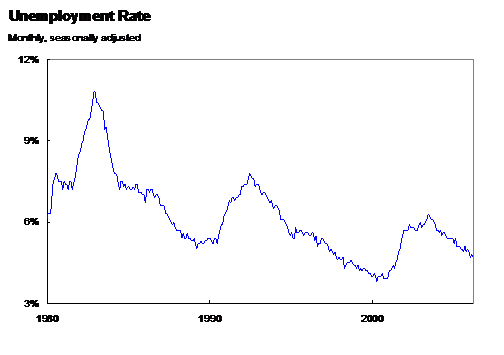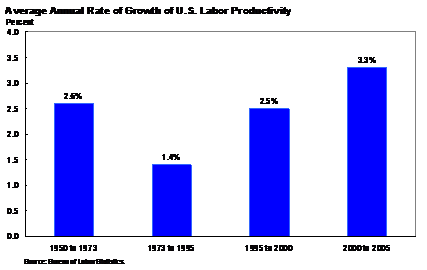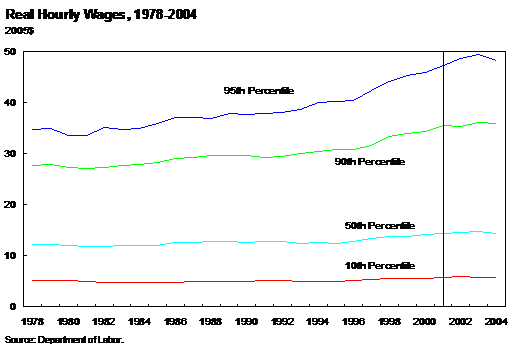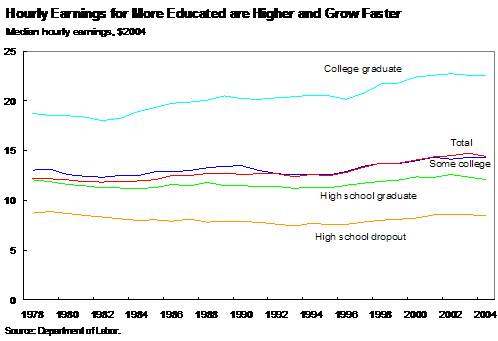
- Afghanistan
- Africa
- Budget Management
- Defense
- Economy
- Education
- Energy
- Environment
- Global Diplomacy
- Health Care
- Homeland Security
- Immigration
- International Trade
- Iraq
- Judicial Nominations
- Middle East
- National Security
- Veterans
- President's Cabinet
- USA Freedom Corps
- Faith-Based & Community Initiatives
- Office of Management and Budget
- National Security Council
- USA.gov
|
Home >
Government >
Council of Economic Advisers
|
Council of Economic Advisors
THE STATE OF THE U.S. ECONOMY AND LABOR MARKET
By Edward P. Lazear
Chairman, President's Council of Economic Advisers
Remarks at the Hudson Institute
May 2, 2006
![]() Full PDF Document (48K)
Full PDF Document (48K)
Thank you, Diana for that kind introduction. As many of you may know, earlier in her career Diana Furchtgott-Roth was a staff economist at the Council of Economic Advisers, and later the Chief of Staff. I am happy to see there is job security for CEA alumni.
It is a pleasure to be here and I am delighted to be given the opportunity to speak about a topic that is on the minds of many Americans. Specifically, I would like to address recent trends in wage growth and the distribution of wages throughout our economy. By this, I mean to engage in a closer examination of the wage growth that has been enjoyed by people at the top of the distribution and those at the bottom.
Recent Performance of the U.S. Economy
The overall picture of the American economy is very favorable. New data from the Commerce Department on Friday showed economic growth was almost 5 percent last quarter as measured by real GDP at an annual rate. That is well above the historical average and the fastest growth in two-and-half years. There was also confirmation that this growth is solid and likely to be sustained. Not only is the labor market strong, but the growth that we have seen in consumer spending and housing is now showing up strongly in growing exports and business investment. The President's policies have helped to create a robust, growing and balanced economy.
Unemployment is down to 4.7 percent. Again, this is well below historical averages. The economy has been adding payroll jobs at a rate of approximately 200,000 per month.

Perhaps most importantly, productivity growth has been very strong at over 3 percent for the past five years. Productivity – how much workers produce per hour – plays a central role in our competitiveness in the global economy. The United States has the most productive economy of any major country in the world and the growth of productivity in recent years will help to keep it that way. And, as I will discuss in a moment, productivity growth ultimately leads to higher standards of living.

Wage Growth
Worker pay has generally been up since 2001. While numbers differ depending on the definition of compensation used as well as the index of inflation, a good number to think about is that real average hourly compensation has grown by about 1.3 percent per year since 2001. Broader measures of income have increased even more, such as real disposable income per capita, which has increased over 8 percent or $2,500 since the President has been in office. Other measures show less growth or even a decrease. To the extent that we do see occasional weaknesses in wage and compensation growth, four factors are worth mentioning.
First, higher benefit costs, like health care, are eating into wages. Employees are seeing more of their compensation in the form of benefits instead of cash wages. For example, real average hourly wages have grown by 0.6 percent per year since 2001, compared to the 1.3 percent growth in compensation including benefits I mentioned earlier.
Second, higher energy prices raise overall inflation which is used to calculate “real” measures of a worker’s pay. Nominal wages have grown steadily since 2001, rising 3.3 percent annually.
Third, wage growth tends to lag productivity growth during the early stages of an economic expansion. As the expansion progresses, wages tend to catch up to productivity growth and eventually the growth rate of wages exceeds that of productivity. We are moving into that phase where we expect that wage growth will catch up and over take productivity growth.
Finally, there is a measurement effect that results from a growing workforce. Given that we have been adding over a couple million jobs per year for the past couple of years, the workforce is moving in the direction of newer workers. Newer workers tend to have wages that are lower than the average, so when we add many new workers to the workforce, average wages look lower than they otherwise would because of the new and less experienced people entering the labor force. This is not a bad thing, as the wages of the new workers will grow over time and eventually will show up in rising wage growth for the population as a whole. Indeed, workers wages’ grow substantially as they gain experience, and this wage growth can dominate any numbers that we see at the aggregate level. For example, workers who were between 25 and 34 years old in 1994 experienced a 52 percent increase in their real earnings over the 10-year period from 1994 – 2004. So, most workers as they move through the experience cycle that occurs over their lifetimes will see substantial improvements in their standards of living.
Labor Market Strength
Structurally, there are some encouraging signs as well in the labor market overall. The occupations where employment is growing tend to be high-wage occupations and the occupations with declining employment tend to be low-wage occupations. Specifically, the growing occupations during the period 2001- 2005 had an average hourly compensation of $30.14 while declining occupations had an average compensation of $21.24. Growing occupations include those in professional and technical services, while declining occupations include workers in office and administrative support and manufacturing. Finally, the low unemployment rate of 4.7 percent suggests that we have very strong labor demand and strong labor demand is usually followed by wage increases.
How about Income Inequality?
An economy with this much good news seems to be one where almost everybody would be better off. But some have suggested that the growth that we see is only enjoyed by the rich while leaving the poor behind. Is this true?
There is little doubt that there has been a 25-year trend of a growing gap, sometimes called income inequality, between the wages of the skilled and the unskilled. While that trend shows no obvious signs of abating in the near future, by some measures inequality has slowed a bit in recent years. The Gini coefficient for household income, which is a broad inequality measure that economists use, was flat between 2001 and 2004 after having increased by 2.7 percent from 1995 to 2000. Similarly, the share of income going to the top 5 percent of households fell between 2001 and 2004 after having risen by over 5 percent from 1995 to 2000. But the general picture cannot be disputed. The difference between the earnings of individuals at the top and earnings of individuals at the bottom has grown.

Causes of Inequality
The term income inequality is a bit misleading because it suggests in a somewhat pejorative way that the rich are getting richer at the expense of the poor. While there is no doubt that some people have been left behind, and that those left behind are certainly a major concern for all of us, there is some good news in this picture. The good new is that most of the inequality reflects an increase in returns to “investing in skills” – workers completing more school, getting more training, and acquiring new capabilities. Our investment in skills are paying off at higher rates today than they did in the past -- and when investments pay off we think of that as a good thing, not a bad thing. The point is best made by looking at the chart of real hourly wages by percentile. The chart shows that the growing inequality is primarily a function not of the bottom declining but rather of it staying flat while the top is growing. Those individuals who have managed to acquire skills in our society have done very well over the past 25 years, whereas those who have not acquired skills have not done well at all. For example, the hourly earnings of college-educated workers have grown by 21.6 percent since 1980, while the hourly earnings of high school drop-outs have fallen by 2.6 percent over the same time period. The fact that there is no growth at the bottom is not positive news, but we are indeed happy about the fact that those who have invested in skills are finding that those investments have paid off with higher wages.
What accounts for this divergence of earnings for the skilled and earnings for the unskilled? Most economists believe that fundamentally this is traceable to technological change that has occurred over the past two or three decades. In our technologically-advanced society, skill has higher value than it does in a less technologically-advanced society. Consider for example, the economy that was in place around the turn of the twentieth century. At that point most workers were engaged either in agriculture or manufacturing. Now it’s true that more-educated farmers grow better wheat than less-educated farmers because they understand crop rotation, soil management and perhaps some aspects of business better than the less educated. But the differences between the profitability of more-educated and less-educated farmers is not likely to be a major source of income variation. However, in our technologically-advanced society, with the growing importance of computers, the types of skills that are required in school and through investment in learning on the job become almost essential in making a worker productive. The typical job that individuals do today requires a much higher level of technical skills than the kinds of jobs that workers did in 1900 or in 1970. Those technical skills can be acquired through formal education or through on the job training, but they must be acquired. In the absence of skill acquisition, workers lag behind both in terms of productivity and the wages that accompany them.
More recently, there is an additional complication. Although average levels of education in this country have grown throughout the century, that increase in education has slowed down a bit in the past two decades. As a result, there is a relative shortage of workers at very high levels of skills, particularly college and even more so post-college graduates. A consequence of supply shortages is that wages increase for those individuals who have the scarce skills and they tend to be at the top. The wages of college and post-college graduates have grown substantially. More recent evidence, however, suggests that trend may be reversing. College enrollment rates are up, as workers seem to be responding to opportunities to gain more from investing in skills.
We worry most about income inequality if that income inequality reflects unequal opportunities. Although unequal outcomes are not necessarily desirable, they are more odious if they are a consequence of the fact that some people are precluded from obtaining the kinds of skills that are required in a modern society.
In order to focus on this, it is essential to recognize that education is the key skill in this equation. College graduates earn about 2-1/2 times as much as high school drop-outs. College graduates have unemployment rates that are currently around 2.2 percent whereas high school drop outs have unemployment rates at about 7 percent. Only a tiny fraction of college graduates live in poverty and those who do are likely to move out of it very quickly as they move into the labor force. There is no doubt that education is a, if not the, solution to the problem. So what is the news on education?

Education
Education has been on the rise in the United States. In 1990 about 45 percent of the population between ages 25 and 34 had completed at least some college. Today, that number is close to 60 percent, and 30 percent of that age group has graduated from college. Furthermore, women are more likely to graduate than men. The college completion rate among females in that age category is 31 percent, compared to 26 percent for males. Additionally, the share of 20- and 21-year-olds who were high school dropouts fell from 15.0 percent in 2001 to 13.9 percent in 2004. That’s a very significant decline in a relative short period of time. College completion, as I mentioned, has taken off again in recent years and this may help mitigate increases in inequality. Rates of return to investment tend to decline when the level in investment in the population as a whole goes up and we can expect some slowing in wage growth among the highly educated. But it is still the case that investment in education is likely to be highly profitable at least for the next decade or so.
Income Mobility
Another point worth making is that there is much income mobility in the U. S. Half of those individuals who are in poverty escape poverty within a 3-year period. When we look at the fifth of the population with the lowest earnings, about 20 percent of people in this group move up after about a year. Additionally, immigrants do very well in this country. The children of immigrants have higher earnings than the average in the U. S. population as a whole. Even though first-generation immigrants do worse than the native-born population, their children find that within one generation, the gap has been eliminated.
Additionally, as I have already mentioned, most workers have significant wage growth over their lifetime as they move through the workforce acquiring more experience, raising their productivity, and getting promotions.
Immigration
Some have suggested that immigration might be causing increased income inequality. There is some controversy here among economists, but the general belief is that immigration does not account for much of the gap between the earnings at the top and earnings at the bottom. Although there may be some groups that have been affected by immigration, the effect seems to be very small. On the whole, immigration may actually increase wages for the economy because immigrants tend to be complements rather than substitutes for native born labor. Take the example of immigrants who end up working at construction sites as roofers. Because of their availability, the electricians, plumbers, and carpenters who work at the same site are more productive and the total cost of the project is lower. Some of this saving is passed on in the form of higher wages to those other workers.
The best evidence on the effect of immigrants on native-born wages actually comes from outside the United States. During the early 1990’s Israel experienced a very large influx of people from the Soviet Union. The number of people coming into the country, which is small in population anyway, was approximately 20 percent the size of the population. Researchers who examine the effect of this influx on the wages of native born have found that there has been no effect to depress native-born wages. Many natives were in occupations that were substitutes for the occupations of the immigrants coming in. It appears that economies are quite fluid and able to absorb new entrants into the labor markets at very high rates and without much damage to the labor market as a whole.
International Trade
What about the effect of international trade? Those who have examined this possibility closely find little support for it. First of all, wages at the bottom tend to be flat and are not correlated with movements in trade. We have seen international trade increase in the past 20 years. Those who might be most susceptible to import competition, such as low-skilled manufacturing workers, do not seem to have had their earnings decreased. While there might be some downward pressure, there is no strong evidence that trade is the culprit. Quite the contrary. Studies have shown that employees of U.S. companies engaged in international trade tend to receive higher wages and benefits than their counterparts in purely domestic companies.
Tax Cuts
Still others have suggested the recent tax cuts might worsen the situation. However, the President’s tax cuts of 2001 and 2003 have played a critical role for workers as they have directly increased the take-home pay of all people who pay income taxes and encouraged economic growth that leads to more jobs and higher pay. Furthermore, the tax cuts have made the tax code more progressive and reduced income inequality. For example, the top 1 percent of earners received 15.4 percent of after-tax income in 2003 compared with 19.0 percent in 2000.
What Can We Do?
It is important that we focus on the portion of our population that has not enjoyed the broad economic growth that has been available to others. Understanding that this is a long-term trend driven by increasing returns to education and skills provides us with important insights into policies that will help this group. We have been making progress in moving people up the education distribution, but we need to do more.
What can we do? Helpful policy actions fall into primarily three areas. First, the government can help set a positive climate for economic growth. Maintaining a low tax and regulatory burden allows for a flexible economy and faster rates of productivity growth. A flexible economy that allows for greater opportunity helps to increase income mobility, while productivity growth helps keep U.S. workers internationally competitive and increase incomes. We should make the President’s tax cuts permanent, for example.
Second, we can help improve the education and skills of workers. As noted earlier, the economy increasingly rewards education and skills. This is a good thing. We would not want it any other way. However, inequality in skills and education levels means inequality in income. At the bottom end of income inequality, focusing on improvements in schools for those who are most disadvantaged seems to be the best investment for society. Programs like No Child Left Behind, which focus on disadvantaged schools, are a way to make sure that individuals who attend those schools will not languish with low prospects for earnings growth. The President’s American Competitiveness Initiative also is a step in the right direction, providing the kinds of science and technical skills that seem to be fundamental in our changing economy.
Additionally, there are other policies that we can consider for those who are already in the workforce. Career Advancement Accounts, which would provide individuals a way to acquire training or retraining, would be a step in this direction. I am confident that with opportunity Americans will improve their situation.
Finally, we can help better align market incentives to address the costs that are pinching worker pay. As I mentioned at the beginning of the speech, high energy prices and health care costs have the effect of reducing real compensation and wages. These are long-term issues that will not be solved by quick fixes.
Last year the President and the Congress passed the first major energy bill in over a decade. It encourages new technologies and updates government regulations. Over time, the new law will help increase the reliability of our energy supply and the efficient use of the energy we have. The President believes we must continue to find new ways to diversify our sources of energy, so he’s proposed the Advanced Energy Initiative to help increase research in alternative energy sources and technology. In the short-term, the President has a four-part plan to address high gasoline prices, but again these are long-term issues that need long-term efforts.
Growth in spending on health care has been more rapid than general inflation, straining consumers, employers, and government budgets. Two years ago, we created Health Savings Accounts (HSAs) to help give patients more control over their health care decisions and to make health care more available and affordable. This year, the President is proposing to enhance HSAs to make them more widely available, valuable to consumers, and attractive to small businesses – and to make it easier for people to keep their insurance policies when they change jobs. The Administration is also working to make more information about price and quality available to consumers.
Americans are Ambitious
The ingenuity, effort and productivity of America’s workers make us the envy of the world. We are the richest and most-rapidly growing industrialized country, and not by accident. We work substantially harder than those in other industrialized countries and it pays off in productivity and wages.
I believe that we can continue to strive to further opportunities for those who are the least advantaged while allowing the top of our society to produce the technology and productivity improvements that spill to others. In doing so, we can ensure that all enjoy in the gains that have been so abundant in recent years.


